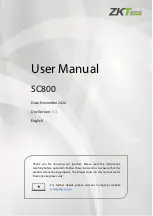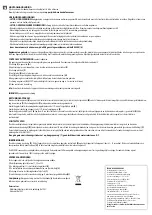
18
Batch Exposure
1. Set the camera to “Bulb” exposure mode.
2. Press the “UTILITY” shortcut key, access to the sub-menu
“Camera Control \ Shoot,” and press the ENTER key.
3. The SynScan hand controller will start the first exposure
set and display the progress data on the screen. A sample
screenshot is shown below:
Shooting#1: 003
Released mm:ss
• The top row shows the set index and the number of
frames pending.
• The bottom row shows the remaining exposure time
of the current frame.
• At the end of each frame, the SynScan hand controller
will give a beep and wait for the pre-set time interval
before the next exposure.
4. During the exposure, you can press the ESC key to
suspend the operation. The screen will display “Shoot
Suspended. 1) Resume 2) Exit.” Press the “1” key to
resume the exposures or press “2” to exit.
Shoot Suspended
1) Resume 2) Exit
6.6 Periodic Error Correction (PEC) for EQ Mount
Almost all equatorial mounts that use worm gears have a peri-
odic tracking error, which is due to slight eccentricities and
misalignments in the gears. Periodic error is not critical for visual
observing but might lower the image quality in long-exposure
astrophotography if not minimized. The SynScan hand control-
ler has a periodic error correction (PEC) function to improve the
tracking performance for astrophotography. The PEC training
function provides a correction to reduce the amplitude of the
worm gear errors. By recording the guiding actions over one full
worm gear cycle, SynScan can then “play back” those actions
with each subsequent worm cycle to compensate for drifting in
the R.A. sidereal tracking caused by periodic error.
Orion equatorial mounts feature two different types of PEC,
depending on the model of the mount. One type is software-
based PEC (SPEC), which applies to Orion’s SkyView Pro GoTo,
Sirius EQ-G, and Atlas EQ-G mounts. The other type is perma-
nent PEC (PPEC), which comes standard with the Atlas Pro AZ/
EQ-G and HDX110 EQ-G mounts. The SynScan hand control-
ler detects the mount model and chooses the appropriate PEC
algorithm.
Note:
PEC training is recommended for advanced users with
interest in long-exposure astrophotography only. Careful guid-
ing is required. Standard sidereal tracking is sufficient for casual
visual applications, and PEC training is not required.
PEC Training
For mounts that support standard, or software-based PEC, such
as the Sirius EQ-G and Atlas EQ-G, you’ll need to manually (visu-
ally) guide for at least one full worm cycle using an illuminated
reticle eyepiece capable of producing at least 300X magnifica-
tion with your telescope. For best results, the true field of view
should not exceed 10 arcminutes.
For mounts that support PPEC, such as the Atlas Pro AZ/EQ-G
and HDX110 EQ-G mounts, an autoguiding camera can be used
instead of manual guiding for the PEC training process. In such
cases, it is recommended to turn on the autoguider for at least
one minute before starting the PEC training process. The total
time for the PEC training of these mounts can be as long as two
cycles of the period error.
The following step-by-step procedure below describes how to
perform the PEC training function manually, using an illuminated
reticle eyepiece.
1. Perform an accurate polar alignment, then perform a
GoTo star alignment.
2. Then choose a star close to the celestial equator, i.e., with
a small Dec. value (Dec. b10° and –10°). This
object will be used as the guide star. Point the telescope
toward it and start the mount tracking.
3. Rotate the reticle eyepiece in the focuser (or diagonal)
until the R.A. movement of the star (i.e., its movement
when you press the Left or Right direction button) runs
parallel to one set of the illuminated crosshairs. Then
center the star on the crosshairs of the eyepiece’s reticle.
4. Access the menu “UTILITY FUNCTION \ PEC Training”
and press the ENTER key. The screen will display “Select
Speed: 1) 0.125X 2) 0.25X.” This is the speed used to
move the star in the FOV of the telescope when you
press the Left or Right direction key on the SynScan
hand controller.
Choosing a 0.125X sidereal rate is
recommended for a longer focal length telescope, and
a 0.25X sidereal rate is recommended for a shorter
focal length telescope.
Press the “1” or “2” key to make a
selection and proceed to the next step.
5. The screen will display the elapsed time once the guide
speed has been selected, indicating that the recording
of the guiding actions has begun. Use the Left and Right
direction keys to control the mount and keep the star
centered in the reticle eyepiece until the PEC training time
is up and the SynScan hand controller stops displaying
the time. (If the star drifts in declination, it doesn’t matter.
PEC is only concerned with corrections of movement in
R.A.) The total time for this training process depends on
your particular mount model, but it will be at least several
minutes. Pressing ESC will immediately stop the recording
and exit from the PEC training function.
PEC Replay
Once PEC training is completed, PEC tracking can be turned on
by accessing “MENU \ Tracking \ PEC+Sidereal,” then press the
ENTER key to start the PEC replay. The SynScan will play back
the guiding corrections you made during the PEC training cycle
to compensate for the periodic error.
Notes:
• The PEC + Sidereal tracking rate will be accurate only after at
least one full cycle of PEC training is performed.















































